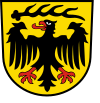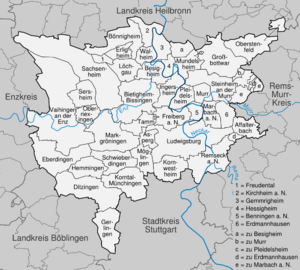Ludwigsburg Rural District facts for kids
Quick facts for kids
Ludwigsburg
|
||
|---|---|---|
|
||
| Country | ||
| State | Baden-Württemberg | |
| Adm. region | Stuttgart | |
| Region | Stuttgart | |
| Capital | Ludwigsburg | |
| Area | ||
| • Total | 687.17 km2 (265.32 sq mi) | |
| Population
(2002)
|
||
| • Total | 506,267 | |
| • Density | 736.742/km2 (1,908.153/sq mi) | |
| Time zone | UTC+1 (CET) | |
| • Summer (DST) | UTC+2 (CEST) | |
| Vehicle registration | LB and VAI | |
| Website | http://www.landkreis-ludwigsburg.de | |
The Ludwigsburg district (in German, Landkreis Ludwigsburg) is a special area in Baden-Württemberg, a state in Germany. Think of a district like a county in other countries.
This district is part of the region Stuttgart, which is in the Stuttgart Government Region. The main city and capital of the district is Ludwigsburg. This city used to be a royal city for the rulers of Württemberg, a historical German state. It is also the biggest city in the district.
Contents
What is the Ludwigsburg District?
The Ludwigsburg district is a place where many people live and work. It covers an area of about 687 square kilometers. That's roughly the size of a large city!
Over 500,000 people call this district home. This makes it a busy and lively area. The district has its own government that helps manage local services. These services include things like schools, roads, and public transport.
Cities and Towns
The Ludwigsburg district has many different cities and smaller towns. Each one has its own unique feel. Some are big cities with lots of shops and businesses. Others are smaller, quieter communities.
Here are some of the main cities and towns you can find in the district:
Major Cities
- Ludwigsburg: The biggest city and the district's capital. It is famous for its beautiful Baroque palace.
- Bietigheim-Bissingen: A large city known for its historic old town and modern areas.
- Kornwestheim: Another important city, often called a "railway city" because of its train connections.
- Ditzingen: A city with a mix of old and new buildings, and a strong economy.
- Vaihingen (Enz): A city located by the Enz river, known for its vineyards.
Smaller Towns and Communities
Besides the big cities, there are many smaller towns and villages. These places often have a more relaxed feel. They are great for exploring nature or enjoying local traditions.
Some examples include:
- Marbach am Neckar: Known as the birthplace of the famous poet Friedrich Schiller.
- Besigheim: A charming town with a medieval look, located at the meeting of two rivers.
- Sachsenheim: A town with historical castles and beautiful landscapes.
- Tamm: A growing community with good connections to larger cities.
- Affalterbach: A smaller village, known for its peaceful surroundings.
How the District is Governed
The Ludwigsburg district has a local government. This government helps make decisions for the people living there. It manages things like:
- Building and maintaining roads.
- Supporting schools and education.
- Organizing public transportation.
- Protecting the environment.
The main office for the district government is in the city of Ludwigsburg. People vote for representatives to be part of the district council. These representatives work together to improve the district for everyone.
Fun Facts About Ludwigsburg District
- The district is known for its beautiful castles and palaces. The Ludwigsburg Residential Palace is one of the largest Baroque palaces in Germany!
- Many parts of the district are covered in vineyards. This means they grow grapes to make wine.
- The Neckar River flows through the district. It's a popular spot for boat trips and walks.
- The area has a rich history, with many old towns and historical sites to explore.



